battery FIAT DOBLO COMBI 2014 Owner handbook (in English)
[x] Cancel search | Manufacturer: FIAT, Model Year: 2014, Model line: DOBLO COMBI, Model: FIAT DOBLO COMBI 2014Pages: 283, PDF Size: 6.31 MB
Page 109 of 283
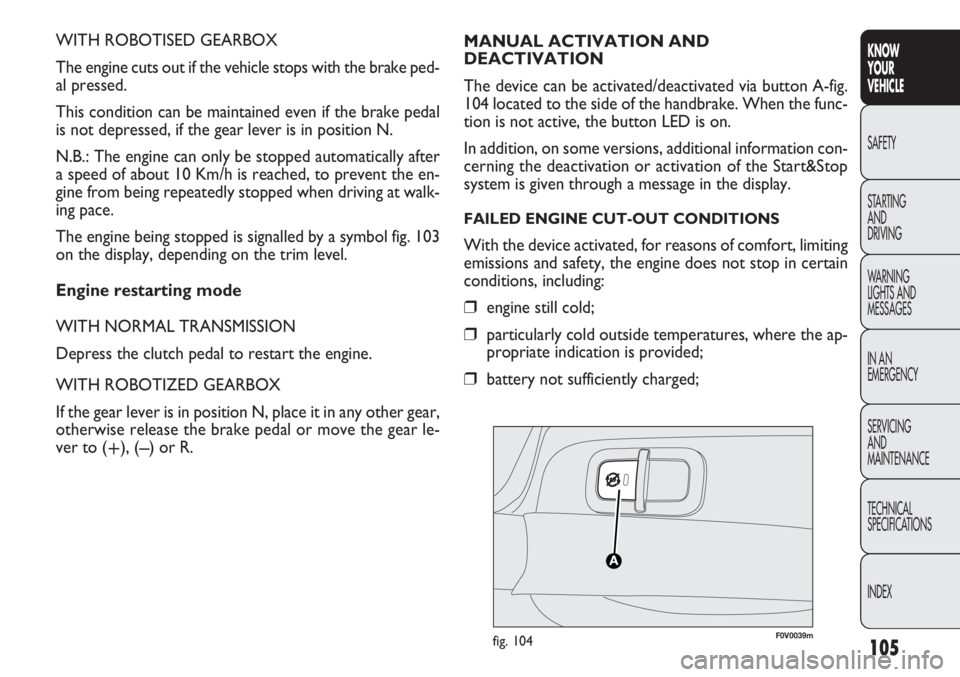
105
KNOW
YOUR
VEHICLE
SAFETY
STAR
TING
AND
DRIVING
WARNING
LIGHTS AND
MESSAGES
IN AN
EMERGENCY
SERVICING
AND
MAINTENANCE
TECHNICAL
SPECIFICATIONS
INDEX
WITH ROBOTISED GEARBOX
The engine cuts out if the vehicle stops with the brake ped-
al pressed.
This condition can be maintained even if the brake pedal
is not depressed, if the gear lever is in position N.
N.B.: The engine can only be stopped automatically after
a speed of about 10 Km/h is reached, to prevent the en-
gine from being repeatedly stopped when driving at walk-
ing pace.
The engine being stopped is signalled by a symbol fig. 103
on the display, depending on the trim level.
Engine restarting mode
WITH NORMAL TRANSMISSION
Depress the clutch pedal to restart the engine.
WITH ROBOTIZED GEARBOX
If the gear lever is in position N, place it in any other gear,
otherwise release the brake pedal or move the gear le-
ver to (
+), (–) or R.
F0V0039mfig. 104
MANUAL ACTIVATION AND
DEACTIVATION
The device can be activated/deactivated via button A-fig.
104 located to the side of the handbrake. When the func-
tion is not active, the button LED is on.
In addition, on some versions, additional information con-
cerning the deactivation or activation of the Start&Stop
system is given through a message in the display.
FAILED ENGINE CUT-OUT CONDITIONS
With the device activated, for reasons of comfort, limiting
emissions and safety, the engine does not stop in certain
conditions, including:
❒engine still cold;
❒particularly cold outside temperatures, where the ap-
propriate indication is provided;
❒battery not sufficiently charged;
Page 110 of 283
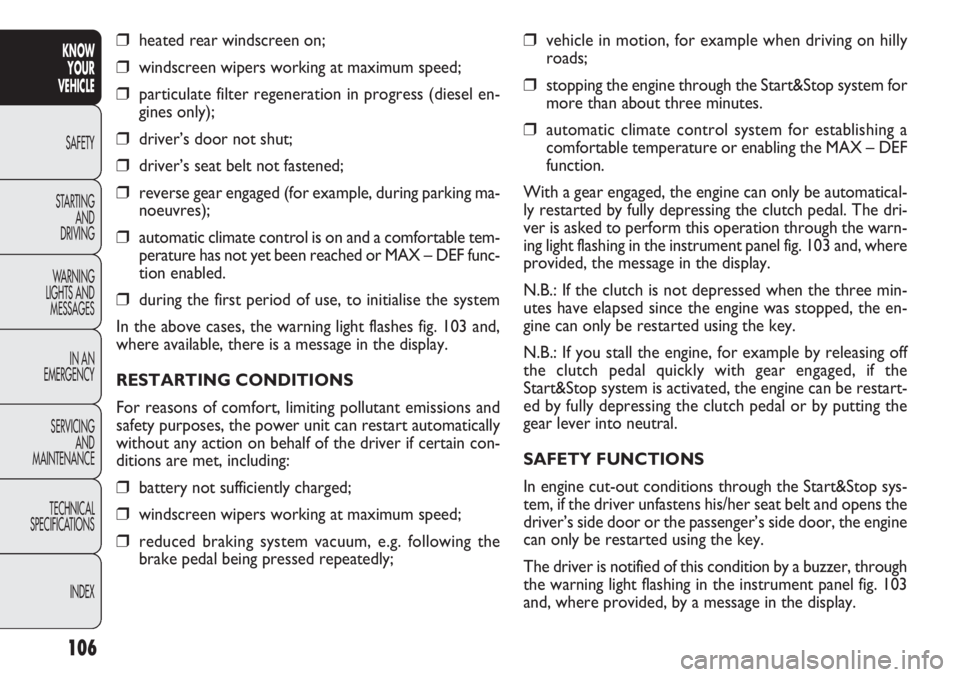
❒vehicle in motion, for example when driving on hilly
roads;
❒stopping the engine through the Start&Stop system for
more than about three minutes.
❒automatic climate control system for establishing a
comfortable temperature or enabling the MAX – DEF
function.
With a gear engaged, the engine can only be automatical-
ly restarted by fully depressing the clutch pedal. The dri-
ver is asked to perform this operation through the warn-
ing light flashing in the instrument panel fig. 103 and, where
provided, the message in the display.
N.B.: If the clutch is not depressed when the three min-
utes have elapsed since the engine was stopped, the en-
gine can only be restarted using the key.
N.B.: If you stall the engine, for example by releasing off
the clutch pedal quickly with gear engaged, if the
Start&Stop system is activated, the engine can be restart-
ed by fully depressing the clutch pedal or by putting the
gear lever into neutral.
SAFETY FUNCTIONS
In engine cut-out conditions through the Start&Stop sys-
tem, if the driver unfastens his/her seat belt and opens the
driver’s side door or the passenger’s side door, the engine
can only be restarted using the key.
The driver is notified of this condition by a buzzer, through
the warning light flashing in the instrument panel fig. 103
and, where provided, by a message in the display.
106
KNOW YOUR
VEHICLE
SAFETY
ST AR
TING AND
DRIVING
WARNING
LIGHTS AND MESSAGES
IN AN
EMERGENCY
SERVICING AND
MAINTENANCE
TECHNICAL
SPECIFICATIONS
INDEX
❒heated rear windscreen on;
❒windscreen wipers working at maximum speed;
❒particulate filter regeneration in progress (diesel en-
gines only);
❒driver’s door not shut;
❒driver’s seat belt not fastened;
❒reverse gear engaged (for example, during parking ma-
noeuvres);
❒automatic climate control is on and a comfortable tem-
perature has not yet been reached or MAX – DEF func-
tion enabled.
❒during the first period of use, to initialise the system
In the above cases, the warning light flashes fig. 103 and,
where available, there is a message in the display.
RESTARTING CONDITIONS
For reasons of comfort, limiting pollutant emissions and
safety purposes, the power unit can restart automatically
without any action on behalf of the driver if certain con-
ditions are met, including:
❒battery not sufficiently charged;
❒windscreen wipers working at maximum speed;
❒reduced braking system vacuum, e.g. following the
brake pedal being pressed repeatedly;
Page 111 of 283
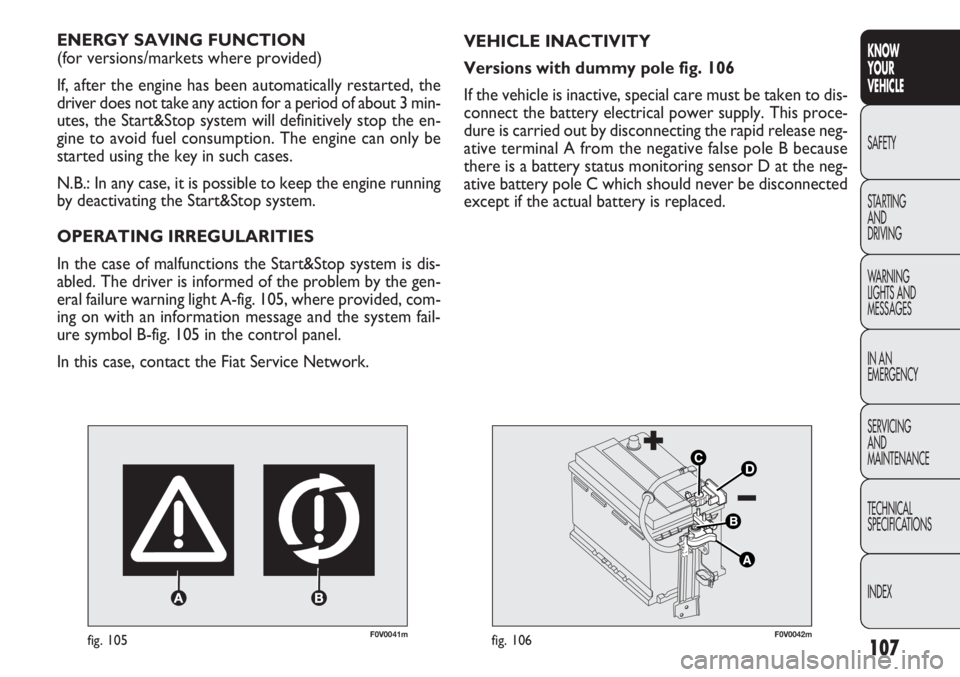
107
KNOW
YOUR
VEHICLE
SAFETY
STAR
TING
AND
DRIVING
WARNING
LIGHTS AND
MESSAGES
IN AN
EMERGENCY
SERVICING
AND
MAINTENANCE
TECHNICAL
SPECIFICATIONS
INDEX
F0V0041mfig. 105
ENERGY SAVING FUNCTION
(for versions/markets where provided)
If, after the engine has been automatically restarted, the
driver does not take any action for a period of about 3 min-
utes, the Start&Stop system will definitively stop the en-
gine to avoid fuel consumption. The engine can only be
started using the key in such cases.
N.B.: In any case, it is possible to keep the engine running
by deactivating the Start&Stop system.
OPERATING IRREGULARITIES
In the case of malfunctions the Start&Stop system is dis-
abled. The driver is informed of the problem by the gen-
eral failure warning light A-fig. 105, where provided, com-
ing on with an information message and the system fail-
ure symbol B-fig. 105 in the control panel.
In this case, contact the Fiat Service Network. VEHICLE INACTIVITY
Versions with dummy pole fig. 106
If the vehicle is inactive, special care must be taken to dis-
connect the battery electrical power supply. This proce-
dure is carried out by disconnecting the rapid release neg-
ative terminal A from the negative false pole B because
there is a battery status monitoring sensor D at the neg-
ative battery pole C which should never be disconnected
except if the actual battery is replaced.
F0V0042mfig. 106
Page 112 of 283
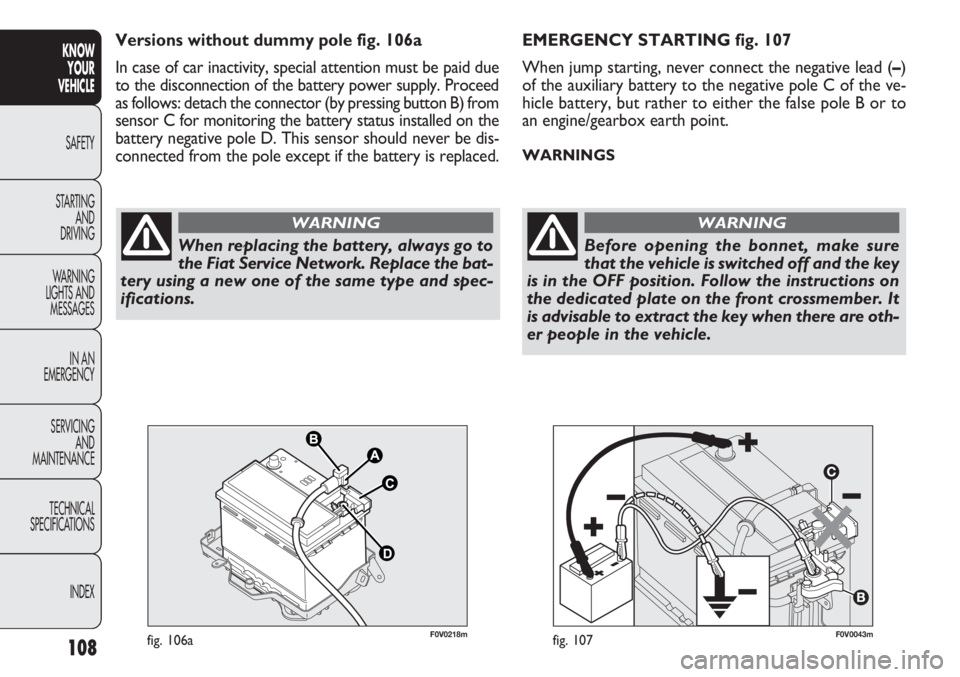
108
KNOWYOUR
VEHICLE
SAFETY
ST AR
TING AND
DRIVING
WARNING
LIGHTS AND MESSAGES
IN AN
EMERGENCY
SERVICING AND
MAINTENANCE
TECHNICAL
SPECIFICATIONS
INDEX
F0V0043mfig. 107
EMERGENCY STARTING fig. 107
When jump starting, never connect the negative lead ( –)
of the auxiliary battery to the negative pole C of the ve-
hicle battery, but rather to either the false pole B or to
an engine/gearbox earth point.
WARNINGS
When replacing the battery, always go to
the Fiat Service Network. Replace the bat-
tery using a new one of the same type and spec-
ifications.
WARNING
Before opening the bonnet, make sure
that the vehicle is switched off and the key
is in the OFF position. Follow the instructions on
the dedicated plate on the front crossmember. It
is advisable to extract the key when there are oth-
er people in the vehicle.
WARNING
F0V0218mfig. 106a
Versions without dummy pole fig. 106a
In case of car inactivity, special attention must be paid due
to the disconnection of the battery power supply. Proceed
as follows: detach the connector (by pressing button B) from
sensor C for monitoring the battery status installed on the
battery negative pole D. This sensor should never be dis-
connected from the pole except if the battery is replaced.
Page 137 of 283
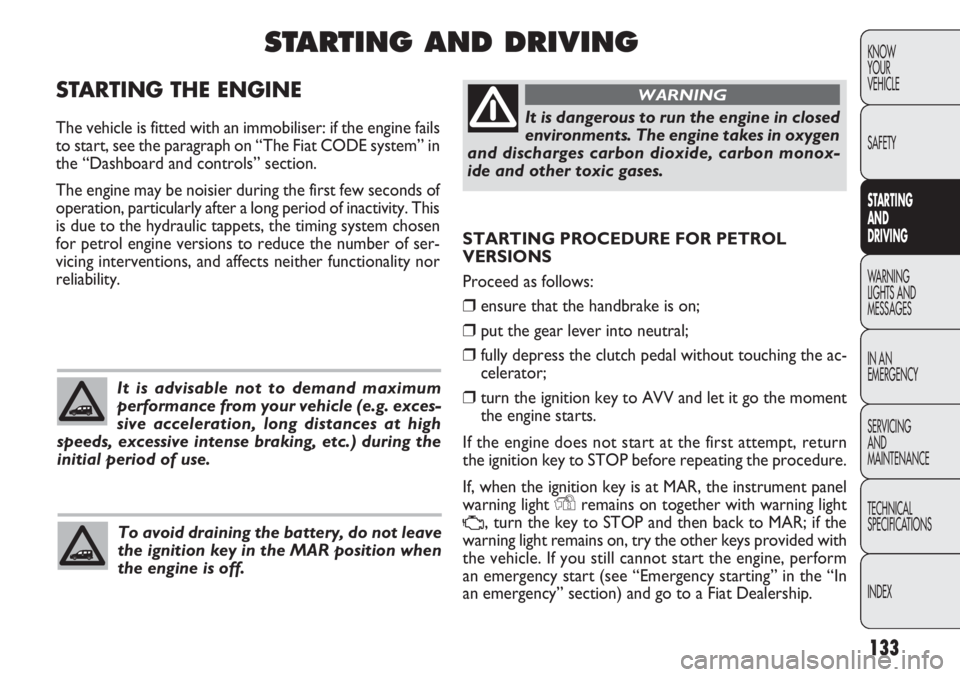
133
KNOW
YOUR
VEHICLE
SAFETY
STARTING
AN
D
DRIVING
WARNING
LIGHTS AND
MESSAGES
IN AN
EMERGENCY
SERVICING
AND
MAINTENANCE
TECHNICAL
SPECIFICA TIONS
INDEX
STARTING PROCEDURE FOR PETROL
VERSIONS
Proceed as follows:
❒ensure that the handbrake is on;
❒put the gear lever into neutral;
❒fully depress the clutch pedal without touching the ac-
celerator;
❒turn the ignition key to AVV and let it go the moment
the engine starts.
If the engine does not start at the first attempt, return
the ignition key to STOP before repeating the procedure.
If, when the ignition key is at MAR, the instrument panel
warning light
Yremains on together with warning light
U, turn the key to STOP and then back to MAR; if the
warning light remains on, try the other keys provided with
the vehicle. If you still cannot start the engine, perform
an emergency start (see “Emergency starting” in the “In
an emergency” section) and go to a Fiat Dealership.
STARTING THE ENGINE
The vehicle is fitted with an immobiliser: if the engine fails
to start, see the paragraph on “The Fiat CODE system” in
the “Dashboard and controls” section.
The engine may be noisier during the first few seconds of
operation, particularly after a long period of inactivity. This
is due to the hydraulic tappets, the timing system chosen
for petrol engine versions to reduce the number of ser-
vicing interventions, and affects neither functionality nor
reliability.
STARTING AND DRIVING
It is advisable not to demand maximum
performance from your vehicle (e.g. exces-
sive acceleration, long distances at high
speeds, excessive intense braking, etc.) during the
initial period of use.
To avoid draining the battery, do not leave
the ignition key in the MAR position when
the engine is off.
It is dangerous to run the engine in closed
environments. The engine takes in oxygen
and discharges carbon dioxide, carbon monox-
ide and other toxic gases.
WARNING
Page 140 of 283
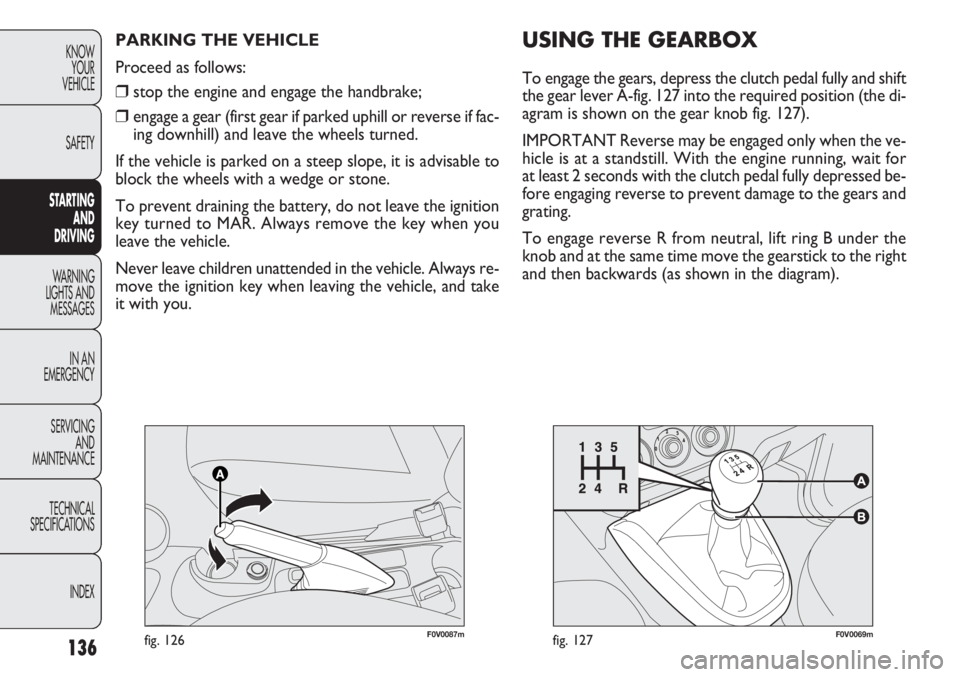
136
KNOWYOUR
VEHICLE
SAFETY
ST ARTING
AN
D
DRIVING
WARNING
LIGHTS AND MESSAGES
IN AN
EMERGENCY
SERVICING AND
MAINTENANCE
TECHNICAL
SPECIFICA TIONS
INDEX
F0V0069mfig. 127F0V0087mfig. 126
PARKING THE VEHICLE
Proceed as follows:
❒stop the engine and engage the handbrake;
❒engage a gear (first gear if parked uphill or reverse if fac-
ing downhill) and leave the wheels turned.
If the vehicle is parked on a steep slope, it is advisable to
block the wheels with a wedge or stone.
To prevent draining the battery, do not leave the ignition
key turned to MAR. Always remove the key when you
leave the vehicle.
Never leave children unattended in the vehicle. Always re-
move the ignition key when leaving the vehicle, and take
it with you.
USING THE GEARBOX
To engage the gears, depress the clutch pedal fully and shift
the gear lever A-fig. 127 into the required position (the di-
agram is shown on the gear knob fig. 127).
IMPORTANT Reverse may be engaged only when the ve-
hicle is at a standstill. With the engine running, wait for
at least 2 seconds with the clutch pedal fully depressed be-
fore engaging reverse to prevent damage to the gears and
grating.
To engage reverse R from neutral, lift ring B under the
knob and at the same time move the gearstick to the right
and then backwards (as shown in the diagram).
Page 146 of 283
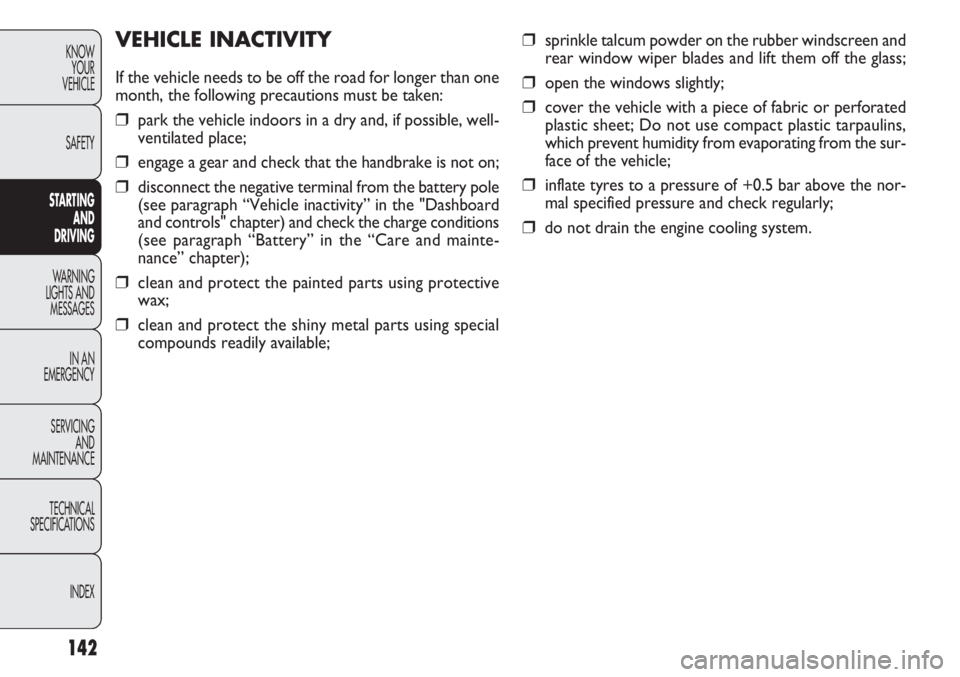
142
KNOWYOUR
VEHICLE
SAFETY
ST ARTING
AN
D
DRIVING
WARNING
LIGHTS AND MESSAGES
IN AN
EMERGENCY
SERVICING AND
MAINTENANCE
TECHNICAL
SPECIFICA TIONS
INDEX
❒sprinkle talcum powder on the rubber windscreen and
rear window wiper blades and lift them off the glass;
❒open the windows slightly;
❒cover the vehicle with a piece of fabric or perforated
plastic sheet; Do not use compact plastic tarpaulins,
which prevent humidity from evaporating from the sur-
face of the vehicle;
❒inflate tyres to a pressure of +0.5 bar above the nor-
mal specified pressure and check regularly;
❒do not drain the engine cooling system.
VEHICLE INACTIVITY
If the vehicle needs to be off the road for longer than one
month, the following precautions must be taken:
❒park the vehicle indoors in a dry and, if possible, well-
ventilated place;
❒engage a gear and check that the handbrake is not on;
❒disconnect the negative terminal from the battery pole
(see paragraph “Vehicle inactivity” in the "Dashboard
and controls" chapter) and check the charge conditions
(see paragraph “Battery” in the “Care and mainte-
nance” chapter);
❒clean and protect the painted parts using protective
wax;
❒clean and protect the shiny metal parts using special
compounds readily available;
Page 149 of 283
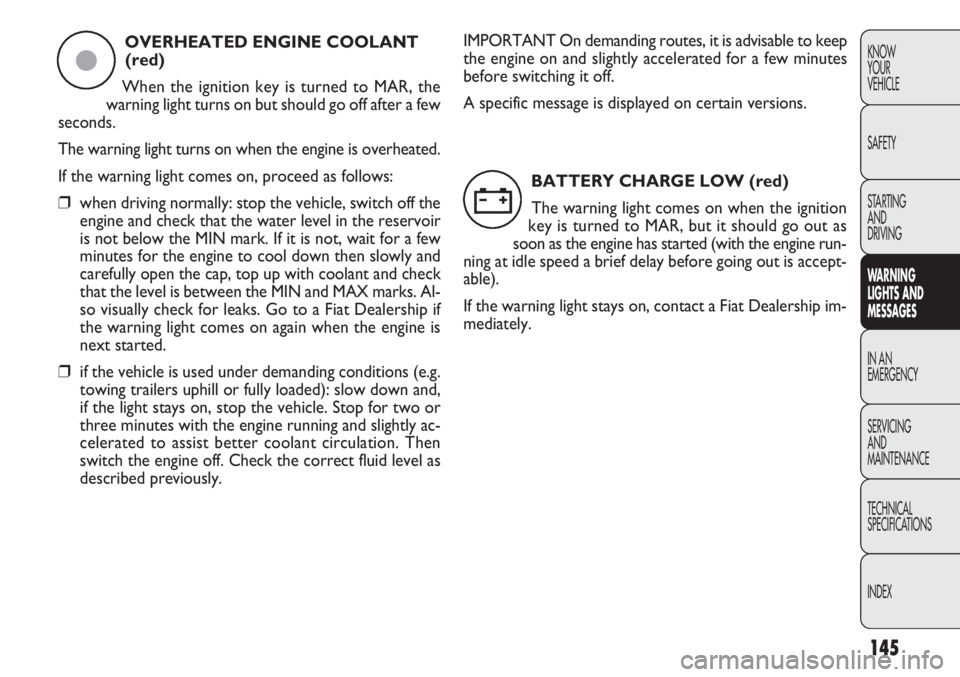
145
KNOW
YOUR
VEHICLE
SAFETY
STARTING
AND
DRIVING
WA R N I NG
LIGHTS AND
MESSAGES
IN AN
EMERGENCY
SERVICING
AND
MAINTENANCE
TECHNICAL
SPECIFICA TIONS
INDEXOVERHEATED ENGINE COOLANT (red)
When the ignition key is turned to MAR, the
warning light turns on but should go off after a few
seconds.
The warning light turns on when the engine is overheated.
If the warning light comes on, proceed as follows:
❒ when driving normally: stop the vehicle, switch off the
engine and check that the water level in the reservoir
is not below the MIN mark. If it is not, wait for a few
minutes for the engine to cool down then slowly and
carefully open the cap, top up with coolant and check
that the level is between the MIN and MAX marks. Al-
so visually check for leaks. Go to a Fiat Dealership if
the warning light comes on again when the engine is
next started.
❒ if the vehicle is used under demanding conditions (e.g.
towing trailers uphill or fully loaded): slow down and,
if the light stays on, stop the vehicle. Stop for two or
three minutes with the engine running and slightly ac-
celerated to assist better coolant circulation. Then
switch the engine off. Check the correct fluid level as
described previously.
ç
IMPORTANT On demanding routes, it is advisable to keep
the engine on and slightly accelerated for a few minutes
before switching it off.
A specific message is displayed on certain versions.
BATTERY CHARGE LOW (red)The warning light comes on when the ignition
key is turned to MAR, but it should go out as
soon as the engine has started (with the engine run-
ning at idle speed a brief delay before going out is accept-
able).
If the warning light stays on, contact a Fiat Dealership im-
mediately.
w
Page 159 of 283
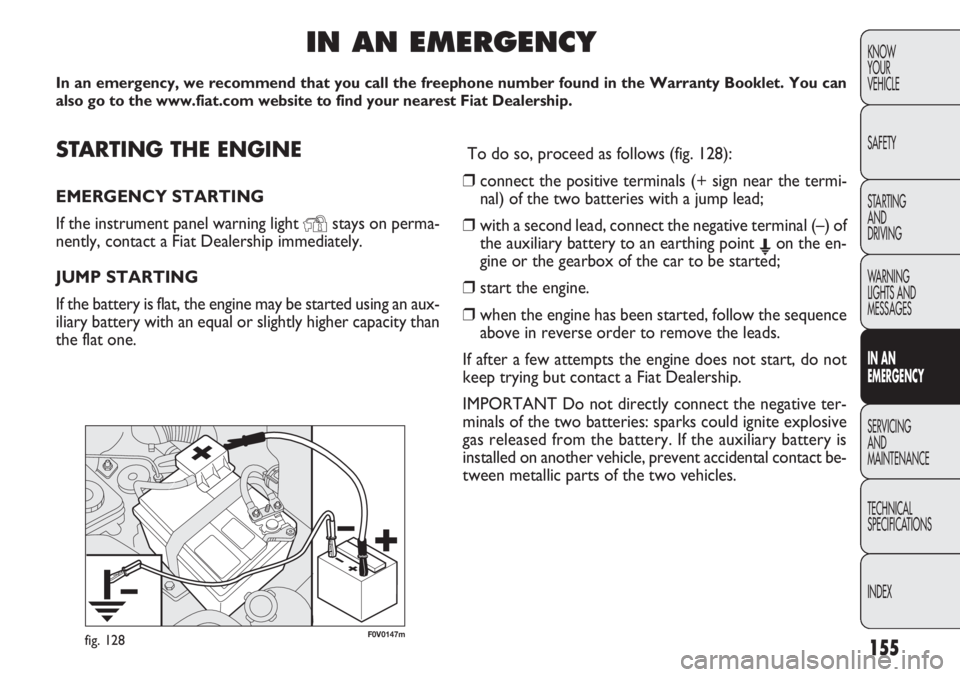
155
KNOW
YOUR
VEHICLE
SAFETY
STARTING
AND
DRIVING
WARNING
LIGHTS AND
MESSAGES
IN AN
EMERGENCY
SERVICING
AND
MAINTENANCE
TECHNICAL
SPECIFICATIONS
INDEX
F0V0147mfig. 128
STARTING THE ENGINE
EMERGENCY STARTING
If the instrument panel warning light
Ystays on perma-
nently, contact a Fiat Dealership immediately.
JUMP STARTING
If the battery is flat, the engine may be started using an aux-
iliary battery with an equal or slightly higher capacity than
the flat one.
IN AN EMERGENCY
In an emergency, we recommend that you call the freephone number found i\
n the Warranty Booklet. You can
also go to the www.fiat.com website to find your nearest Fiat Dealership\
.
To do so, proceed as follows (fig. 128):
❒ connect the positive terminals (+ sign near the termi-
nal) of the two batteries with a jump lead;
❒ with a second lead, connect the negative terminal (–) of
the auxiliary battery to an earthing point E on the en-
gine or the gearbox of the car to be started;
❒ start the engine.
❒ when the engine has been started, follow the sequence
above in reverse order to remove the leads.
If after a few attempts the engine does not start, do not
keep trying but contact a Fiat Dealership.
IMPORTANT Do not directly connect the negative ter-
minals of the two batteries: sparks could ignite explosive
gas released from the battery. If the auxiliary battery is
installed on another vehicle, prevent accidental contact be-
tween metallic parts of the two vehicles.
Page 160 of 283
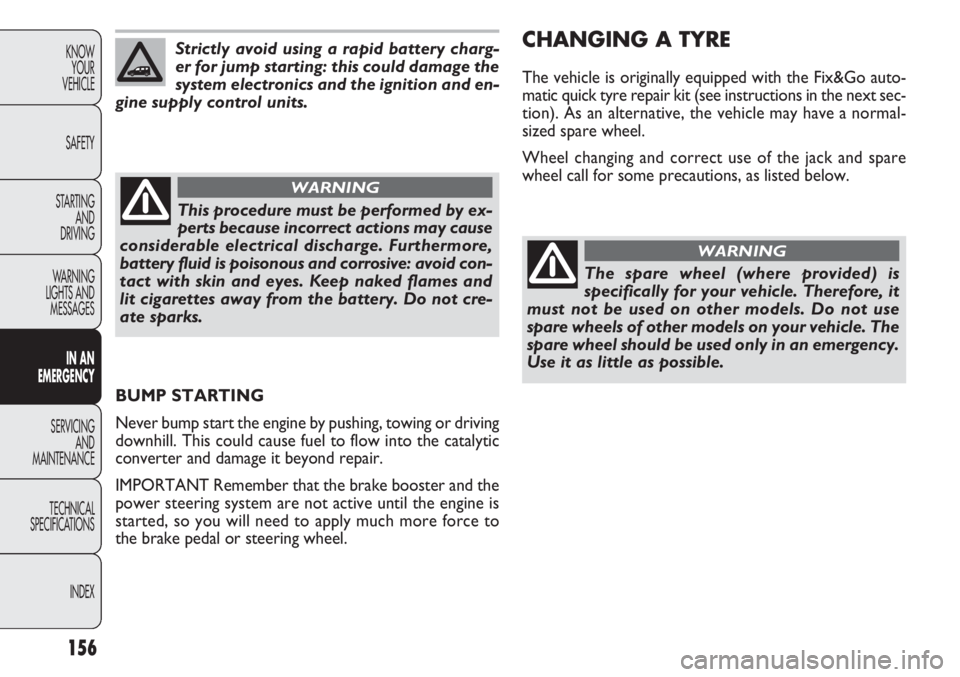
156
KNOWYOUR
VEHICLE
SAFETY
STARTING AND
DRIVING
WARNING
LIGHTS AND MESSAGES
IN AN
EMERGENCY
SERVICING AND
MAINTENANCE
TECHNICAL
SPECIFICA TIONS
INDEXStrictly avoid using a rapid battery charg-
er for jump starting: this could damage the
system electronics and the ignition and en-
gine supply control units.
This procedure must be performed by ex-
perts because incorrect actions may cause
considerable electrical discharge. Furthermore,
battery fluid is poisonous and corrosive: avoid con-
tact with skin and eyes. Keep naked flames and
lit cigarettes away from the battery. Do not cre-
ate sparks.
WARNING
BUMP STARTING
Never bump start the engine by pushing, towing or driving
downhill. This could cause fuel to flow into the catalytic
converter and damage it beyond repair.
IMPORTANT Remember that the brake booster and the
power steering system are not active until the engine is
started, so you will need to apply much more force to
the brake pedal or steering wheel.
CHANGING A TYRE
The vehicle is originally equipped with the Fix&Go auto-
matic quick tyre repair kit (see instructions in the next sec-
tion). As an alternative, the vehicle may have a normal-
sized spare wheel.
Wheel changing and correct use of the jack and spare
wheel call for some precautions, as listed below.
The spare wheel (where provided) is
specifically for your vehicle. Therefore, it
must not be used on other models. Do not use
spare wheels of other models on your vehicle. The
spare wheel should be used only in an emergency.
Use it as little as possible.
WARNING